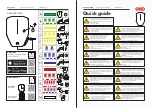
TIRE PRESSURE MONITORING SYSTEM (TPMS) DIAGNOSIS
TSB Revision
WHEEL AND TIRE
31-35
STEP 2. After the tire inflation pressure is adjusted and the
TPMS transmitter sends inflation pressure information on
it, check the TPMS warning light.
(1) Wait until the tires cool down, and adjust road tire inflation
pressures to the value specified on the tire pressure label.
(2) Turn the ignition switch (engine starting switch) to the ON
position.
(3) Drive the vehicle for five minutes.
(4) Check the TPMS warning light.
Q: Is the TPMS warning light turned off?
YES :
The procedure is complete.
NO :
Go to Step 3.
STEP 3. Check the tire inflation pressure again.
Use a tire pressure gauge to check that road tire inflation pres-
sures meet the value specified on the tire pressure label.
Q: Is the check result normal?
YES :
Go to Step 4.
NO :
Replace the valve or valve core, or repair the
damaged tire. Replace the tire if necessary. Then
return to Step 2.
STEP 4. Using scan tool MB991958, diagnose the CAN bus
lines.
Use scan tool to diagnose the CAN bus lines.
Q: Is the check result normal?
YES :
Go to Step 5.
NO :
Repair the CAN bus lines (Refer to GROUP 54C
CAN Bus Diagnostics Table
P.54C-12
). Then go to
Step 5.
STEP 5. Using scan tool MB991958, read the diagnostic
trouble code.
Use scan tool MB991958 to check whether DTC C1912,
C1922, C1932 or C1942 (Tire air pressure low) is set.
Q: Is DTC C1912, C1922, C1932 or C1942 set?
YES :
Carry out troubleshooting for DTC C1912, C1922,
C1932 or C1942 (Tire air pressure low) (Refer to
P.31-28
).
NO :
Replace the ETACS-ECU <vehicles without Keyless
Operation System> or KOS&OSS-ECU <vehicles
with Keyless Operation System> (Refer to
P.31-46
)
and execute "Tire Pressure Sensor ID Registration"
on scan tool MB991958 "Special Function" (Refer to
P.31-42
). Then go to Step 6.
















































